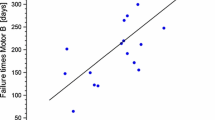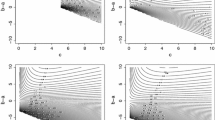Abstract
In this paper we develop a general class of bivariate discrete distributions. The basic idea is quite simple. The marginals are obtained by taking the random geometric sum of the baseline random variables. The proposed class of distributions is a flexible class of bivariate discrete distributions in the sense the marginals can take variety of shapes. The probability mass functions of the marginals can be heavy tailed, unimodal as well as multimodal. It can be both over dispersed as well as under dispersed. We discuss different properties of the proposed class of bivariate distributions. The proposed distribution has some interesting physical interpretations also. Further, we consider two specific base line distributions: Poisson and negative binomial distributions for illustrative purposes. Both of them are infinitely divisible. The maximum likelihood estimators of the unknown parameters cannot be obtained in closed form. They can be obtained by solving three and five dimensional non-linear optimizations problems, respectively. To avoid that we propose to use expectation maximization algorithm, and it is observed that the proposed algorithm can be implemented quite easily in practice. We have performed some simulation experiments to see how the proposed EM algorithm performs, and it works quite well in both the cases. The analysis of one real data set has been performed to show the effectiveness of the proposed class of models. Finally, we discuss some open problems and conclude the paper.
Similar content being viewed by others
References
Adamidis, K. (1999). An EM algorithm for estimating negative binomial parameters. Australian New Zealand J. Statist. 41, 213–221.
Barreto-Souza, W. (2012). Bivariate gamma-geometric law and its induced Levy process. J. Multivar. Anal. 109, 130–145.
Basu, A.P. and Dhar, S.K. (1995). Bivariate geometric distribution. J. Appl. Statist. Sci. 2, 33–34.
Campbell, J.T. (1934). The Poisson correlation function. In Proceedings of the Edinburgh Mathematical Society, Series 2, vol. 4, pp. 18–26.
Chahkandi, M. and Ganjali, M. (2009). On some lifetime distributions with decreasing failure rate. Comput. Statist. Data Anal. 53, 4433–4440.
Davis, C.S. (2002). Statistical Methods for the Analysis of Repeated Measurements. Springer, New York.
Holgate, B. (1964). Estimation for the bivariate Poisson distribution. Biometrika 51, 241–245.
Jayakumar, K. and Mundassery, D.A. (2007). On a bivariate geometric distribution. Statistica LXVII, 389–404.
Kemp, A.W. (2013). New discrete Appell and Humbert distributions with relevance to bivariate accident data. J. Multivar. Anal. 113, 2–6.
Kocherlakota, S. (1995). Discrete bivariate weighted distributions under multiplicative weight function. Commun. Statist. Theory Methods 24, 533–551.
Kocherlakota, S. and Kocherlakota, K. (1992). Bivariate Discrete Distributions. Marcel and Dekker, New York.
Kostadinova, K. and Minkova, L. (2014). On a bivariate Poisson negative binomial process. Biomath 3, 1–6.
Kumar, C.S. (2008). A unified approach to bivariate discrete data. Metrika 67, 113–123.
Kundu, D. (2014). Geometric skewed normal distribution. Sankhya, Ser. B. 76, 167–189.
Kundu, D. (2017). Multivariate geometric skew normal distribution. Statistics 51, 1377–1397.
Kundu, D. and Nekoukhou, V. (2018). Univariate and bivariate geometric discrete generalized exponential distributions. J. Statist. Theory Pract. 12, 595–614.
Kozubowski, T.J., Panorska, A.K. and Podgorski, K. (2008). A bivariate Levy process with negative binomial and gamma marginals. J. Multivar. Anal. 199, 1418–1437.
Kozubowski, T.J., Panorska, A.K. and Qeadan, F. (2011). A new multivariate model involving geometric sums and maxima of exponentials. J. Statist. Planning Inference 141, 2353–2367.
Lee, H. and Cha, J.H. (2014). On construction of general class of bivariate distributions. J. Multivar. Anal. 127, 151–159.
Lee, H. and Cha, J.H. (2015). On two general classes of discrete bivariate distributions. Am. Statist. 69, 221–230.
Minkova, L.D. and Balakrishnan, N. (2014). Bivariate Pólya-Aeppli distribution. Commun. Statist. Theory Methods 43, 5026–5038.
Nekoukhou, V. and Kundu, D. (2017). Bivariate discrete generalized exponential distribution. Statistics 51, 1143–1158.
Ozel, G. (2011). On certain properties of a class of bivariate compound Poisson distribution and an application to earthquake data. Revista Colombiana de Estadstica34, 545–566.
Piperigou, V.E. and Papageorgiou, H. (2003). On bivariate discrete distributions: A unified treatment. Metrika 58, 221–233.
Ye, Y. (2015). Likelihood Inference for Type-I Bivariate Pólya-Aeppli Distribution. MS Thesis, McMaster University.
Acknowledgements
The author would like to than the unknown reviewers for providing constructive suggestions to improve the paper significantly.
Author information
Authors and Affiliations
Corresponding author
Additional information
Publisher’s Note
Springer Nature remains neutral with regard to jurisdictional claims in published maps and institutional affiliations.
Appendices
Appendix A: Exact Expressions of C(a, j)
Note that for
To compute C(a,1), first observe that
and
Hence
Therefore
Now to compute C(a,2), note that
If we denote \(\displaystyle S = \sum \limits _{k = 0}^{\infty } e^{-a k} k(k-1)\), then
and
Hence
Therefore,
We will use the following notations:
Then using the fact
We can easily obtain the following relation
Further note that if we denote
then C0m, C1m⋯ ,Cm− 1,m can be obtained recursively from the following set of linear equations. C0m = 1 and
If we use the following notations for n < m;
\(\displaystyle a_{mm} = \prod \limits _{i = 1}^{m} i\), then clearly
and we obtain
Since we have
we can obtain recursively C(a, m + 1) from C(a, m).
Appendix B: Expressions of P(N = n|X = x, Y = y)
In this appendix we provide the expressions of P(N = n|X = x, Y = y) for both BPG and BNBG models. Suppose (X, Y ) ∼ BPG(λ1, λ2, p), then
Now to compute arg maxnP(N = n|X = x, Y = y), we consider
It is immediate that either g(n) is a decreasing function or it is an unimodal function and if n∗ = arg maxnP(N = n|X = x, Y = y), then n∗ is the smallest integer greater than
Now suppose (X, Y ) ∼BNBG(r1, 𝜃1, r2, 𝜃2, p), then
Hence,
In this case because of the complicated nature of g(n), it is not possible to show that g(n) has a unique maximum. But in all our numerical experiments it has been observed that g(n) has a unique maximum. We have chosen n∗ to be the minimum n, such that g(n) < 1.
Appendix C: EM Algorithm for Non-Identical NB Distribution
In this Appendix we will show that if Xi ∼ NB(nir, 𝜃), Xi’s are independent, ni’s are known for i = 1,…,m, then how to obtain MLEs of r and 𝜃, based on a sample {x1,…,xm}. In this case we will be using an EM algorithm very similar to Adamidis (1999). We use the following notation: α = −(ln(1 − 𝜃))− 1, r = αλ and provide the algorithm to compute the MLEs of λ and 𝜃. It is observed that in this case at each E-step, the corresponding M-step can be obtained in explicit forms. Using the same notation as in Adamidis (1999), it can be easily seen that for i = 1,…,m,
here Yij’s are i.i.d. logarithmic series distribution (LSD) with PDF
Mi ∼PO(niλ) and all the random variables are independently distributed. Further, if Zij’s are i.i.d. random variables with PDF
and 0, otherwise, then the log-likelihood function of the ‘complete data’ (Yij, Zij, Mi;i = 1,…,m, j = 1,…,Mi), without the additive constant can be written as
here \(\displaystyle \widetilde {n} = \sum \limits _{i = 1}^{m} n_{i}\). Hence, the MLEs of λ and 𝜃 based on the complete observations can be easily obtained as
Hence, following the same way as in Adamidis (1999), it can be easily seen that if at the k-th stage the estimates of λ and 𝜃 are λ(k) and 𝜃(k), respectively, and if we denote
then
Here \(\displaystyle \widetilde {x} = \sum \limits _{i = 1}^{m} x_{i}\).
Rights and permissions
About this article
Cite this article
Kundu, D. On a General Class of Discrete Bivariate Distributions. Sankhya B 82, 270–304 (2020). https://doi.org/10.1007/s13571-019-00194-x
Received:
Published:
Issue Date:
DOI: https://doi.org/10.1007/s13571-019-00194-x
Keywords and phrases.
- Discrete distributions
- Joint probability mass function
- Bivariate generating function
- Infinite divisibility
- Method of moment estimators




